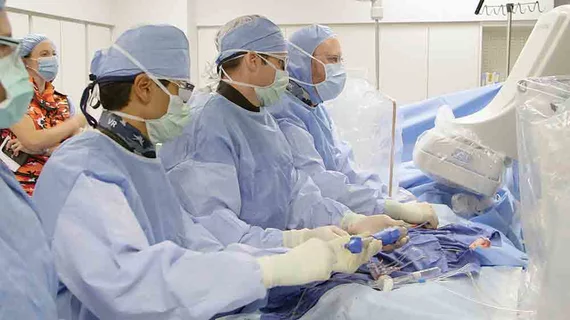TAVR, SAVR linked to equal survival in patients at intermediate surgical risk
Transcatheter aortic valve replacement (TAVR) was easily the treatment of choice in German patients with severe stenosis at intermediate surgical risk from 2012 to 2014, according to a registry study, with both TAVR and surgical AVR (SAVR) carrying a 3.6 percent risk of in-hospital mortality.
One-year mortality outcomes were a bit more complicated to dissect, with unadjusted death rates of 17.5 percent after TAVR and 10.8 percent after SAVR. However, patients in the TAVR group were six years older on average and had higher risk scores both in terms of EuroSCORE and Society of Thoracic Surgeons (STS) score.
After propensity matching 661 patients to even out their clinical characteristics, the difference in one-year mortality wasn’t statistically significant (17.1 percent for TAVR; 15.7 percent for SAVR).
“In accordance with the results from randomized controlled trials, this large registry analysis suggests that both TAVR and SAVR are reasonable treatment options in a real-world population with aortic stenosis and intermediate surgical risk,” wrote lead author Nicolas Werner, MD, and colleagues in Circulation. “An individualized therapeutic decision by a dedicated heart team based on a patient’s clinical situation, relevant co-morbidities, and individual procedural risk may currently be the best approach for patients with intermediate surgical risk.”
The study population included individuals from the German Aortic Valve Registry who were treated with isolated TAVR or SAVR for severe aortic stenosis and were deemed at intermediate surgical risk, by virtue of an STS score of 4 percent to 8 percent. Of the patients meeting this criteria between 2012 and 2014, 6,469 underwent TAVR and 1,144 underwent SAVR.
“Multivariable analysis revealed that patients in a worse clinical and functional condition and at higher age were more likely to be treated by TAVR,” the authors wrote, noting other predictors of undergoing TAVR versus SAVR included coronary artery disease, New York Heart Association class III/IV, pulmonary hypertension, arterial occlusive disease and a lack of diabetes.
The top documented reasons for clinicians performing SAVR included age (82.5 percent), frailty (50.8 percent) and patient request (26.2 percent).
“Based on our findings, treatment decisions by interdisciplinary heart teams were … based on a multitude of additional clinical factors that are not considered in surgical risk scores but are well-known to influence patient outcome,” Werner et al. wrote. “This is in line with current guideline recommendations to consider additional individual and clinical factors that are not reflected in the available risk scores but appreciably influence outcome.”
But that same ambiguity can make it hard to determine how those characteristics affect long-term outcomes, muddying comparisons of the procedures even with an attempt at propensity-score matching, the authors said.
“Our propensity score-matched cohort represents approximately 18% of the total intermediate-risk population only; the need for exclusion of a majority of patients underlines the difficulty in comparing two vastly different patient groups,” they acknowledged.
With that in mind, Werner and colleagues reiterated either procedure could be an appropriate approach in patients at intermediate risk defined by the STS score. They pointed out even the most recent TAVR trials “did not include the latest state-of-the-art technology,” which has shown the ability to further reduce complication rates.

